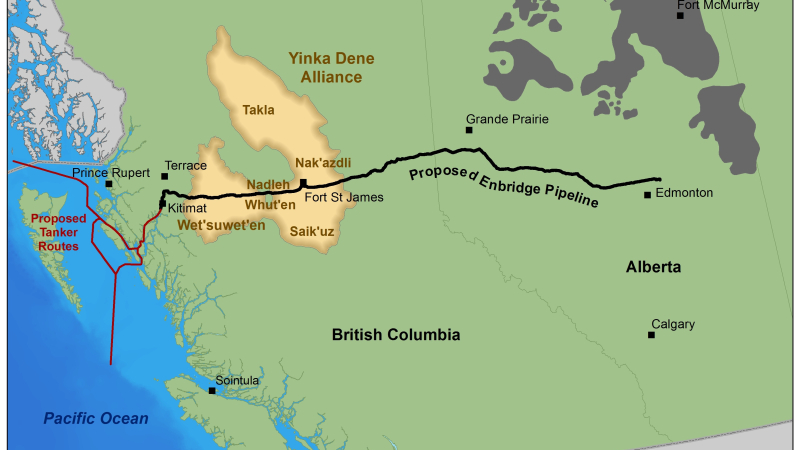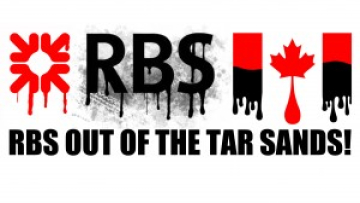
Project – On record
This profile is no longer actively maintained, with the information now possibly out of date
Project – On record
This profile is no longer actively maintained, with the information now possibly out of dateWhat must happen
Private banks must not participate in funding of this project, whatever forms it takes, be it project finance, general corporate loans or underwriting of shares or bonds.
| Sectors | Pipeline Transportation of Crude Oil, Pipeline Transportation of Natural Gas |
| Location |
|
| Status |
Planning
Design
Agreement
Construction
Operation
Closure
Decommission
|
| Website | http://www.gatewayfacts.ca/ |
The Enbridge Pipelines involve two pipelines from Bruderheim Alberta (near Edmonton), to a new marine terminal in Kitimat, British Columbia. The East pipeline is to import natural gas condensate while the West pipeline is to export crude oil. There is also a proposition to build a new marine terminal in Kitimat. The proposing company is Enbridge Inc., a Canadian company that operates the world's longest crude oil and liquids pipeline system.
The project is planned to consist of two parallel pipelines between an inland terminal at Bruderheim, Alberta and a marine terminal near Kitimat, British Columbia in length of 1,177 kilometers both. About 520 kilometers of pipeline will run in Alberta and 657 kilometers in British Columbia. The crude oil pipeline would have a diameter of 36 inches and its capacity would be 525 thousand barrels per day. The condensate pipeline would have diameter of 20 inches with capacity of 193,000 barrels of condensate per day. Enbridge expected these pipelines to be completed by 2015. It is expected to cost at least CAD4.5 billion.
Social and human rights impacts
The social impacts of this project are vast and various. The concern underlining each of these impacts is directly related to the affected communities. The proposed pathway of the pipeline crosses the territories of over fifty First Nations groups. So far the pipeline is opposed by nine different Coastal First Nations and many more inland First Nations communities located along the pipeline. The various communities have been actively opposing the project and have voiced these concerns in regard to the social impacts. Some of the concerns are:
- Employment: The jobs created due to the project would mostly be in the construction phase. These jobs are short-run and unsustainable. The communities are concerned that these jobs won't actually benefit them.
- Regional Multiplier Effects: The communities feel that the multiplier effects which are claimed to benefit surrounding economies are unlikely to benefit the First Nations' economies due to the structure of their economies.
- Government Revenue: It is thought that the government revenue from the project won't actually benefit the First Nations communities.
- Cultural Impact: Many First Nations people are concerned this pipeline and possible spills will have a devastating impact on cultural activities including: hunting, fishing, trapping, berry picking, spiritual activities, traditional village sites, recreation sites and travel routes. There is also the concern that the pipeline route will fragment the land even further than before, by creating artificial boundaries, creating disturbances to the land, wildlife and fish.
- Treaty rights and land title: The pipeline will decrease the amount of land available for land claim settlement due to fragmentation and privatization of the right of way.
Environmental and climate impacts
There are also many environmental concerns attached to this project. One of the biggest concerns is the threat of an oil spill and the implications this will have on the environment. Enbridge does not have a good record when it comes to oil spills. In fact, between 1999 and 2008, Enbridge lists 610 spills that released approximately 21 million litres (132,000 barrels) of hydrocarbons. The threat of a spill is heightened due to the fact that the proposed path of the Enbridge Northern Gateway pipeline will cross around 1,000 streams and rivers, including sensitive salmon spawning habitat in the upper Fraser, Skeena, and Kitimat watersheds. Five important salmon rivers that would be impacted are the Stuart River, Morice River, Copper River, Kitimat River and Salmon River. Other concerns addressed by the First Nations communities include:
- Habitat destruction: The areas to be cleared by the pipeline construction, road building and upgrading will experience continuous disturbances and alterations. The concern here is the effects this will have on the soil and the terrain stability, impacts on flora and fauna, etc.
- Vegetation: At the same time, due to the clearing of the land for the construction, trees, shrubs and ground cover will be removed, including old growth forest which is now only 15-20% of the territory.
- Wildlife and wildlife habitat: The construction could also disturb and contaminate wildlife habitat, travel and migration.
- Air and Noise pollution: There are concerns from the local communities of the high levels of emissions as well as the noise which will disturb local way of life and wildlife.
- Water quality: The pipeline will cross many rivers and streams as well as wetlands, ponds and lakes. The pipeline could degrade the water quality through erosion, sedimentation, and contamination.
- Fish and habitat: Construction could affect fish during spawning periods, loss of marine plants could affect food chain, water contamination could impact fish and marine plants, etc. Go to the full report here.
A July 2017 Greenpeace report concluded: oil spills anywhere pose serious risks to human health and the environment, and oil spilled into bodies of water is difficult to fully clean up. Diluted bitumen transported from Canada’s tar sands fields represents a particular threat to water resources along the routes of proposed pipelines.
First Nations in BC declare opposition against Enbridge's Northern Gateway Pipeline
2017
2017-01-25 00:00:00 | Enbridge withdraws Northern Gateway pipeline project
Enbridge has formally withdrawn the project from the Britisch Columbia environmental assesment process. This is the expected final step in bringing the project to an end. The federal government rejected the project at the end of November. Trudeau said "It has become clear that this project is not in the best interest of the local affected communities, including Indigenous Peoples".
2016
2016-06-30 00:00:00 | Northern Gateway pipeline approval overturned
The Federal Court of Appeal has overturned approval of Enbridge's controversial Northern Gateway project after finding Ottawa failed to properly consult the First Nations affected by the pipeline. "We find that Canada offered only a brief, hurried and inadequate opportunity ... to exchange and discuss information and to dialogue," the ruling says (source CBC News).
2015
2015-11-13 00:00:00 | Crude oil tanker ban for B.C.'s North Coast ordered by Trudeau
Prime Minister Justin Trudeau has called for a moratorium on crude oil tanker traffic for B.C.'s North Coast. Trudeau outlined the directive in a mandate letter to Canada's transport minister, Marc Garneau, on Friday. In it, he asked Garneau to formalize the agreement with three other ministries: fisheries, natural resources and environment.
2011
2011-05-12 00:00:00 | Project status so far
The project is moving forwards as a joint review panel hearing on the Pipeline is set to go through Whitecourt on Jan. 10, 2012. During the April 2011 election in Canada Enbridge politically backed the Conservative party and Stephen Harper, stating that this project will make Canada a world leader. Harper has shown outright support for the project and is on record stating "he did not favour turning the federal government's limited, unwritten, moratorium on oil tanker traffic off B.C.'s North Coast into an outright ban." On May 2nd Harper was elected with majority in Canada giving Enbridge the hope that the project will be pushed through.
Sinopec Corp, China's second largest oil producer and top refiner, is a member of a consortium of producers and refiners that has provided about CAD100 million to fund the line's regulatory and development costs. In doing so they are guaranteed space on the line and the right to take an equity stake. So far Sinopec is the only member of the Northern Gateway group that has been identified.
Even with the above mentioned support, Enbridge is beginning to see that the risks and oppositions are much greater than they had anticipated. They have seen legal opposition from First Nations' communities and as stated by Nikki Skuce of Forestethics "If the project isn't stopped by a First Nations legal case, it will be stopped by a federally legislated tanker ban. If it's not stopped by the environmental review process, it will be delayed by lack of shipper agreements. If all else fails, First Nations and community resistance will rise up and take action," said Nikki Skuce, in the report "Enbridge Northern Gateway Pipelines: community opposition and investment risk."
On December 4, 2009, the National Energy Board (NEB) and the Canadian Environmental Assessment Agency (CEAA) issued the Joint Review Panel Agreement and the Terms of Reference for the environmental and regulatory review for the Northern Gateway Pipelines. Enbridge Northern Gateway submitted its project application to the NEB on May 27, 2010. A Joint Review Panel, established by the Minister of the Environment and the National Energy Board, will assess the eight volume regulatory application.
Sinopec Corp., China's second-largest energy company, struck a new partnership with Enbridge Inc. It is still unknown whether the government-controlled company will invest directly in the project. So far, Sinopec is involved in the pre-stage work and providing support.

